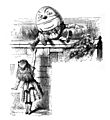Jabberwocky facts for kids
"Jabberwocky"
’Twas brillig, and the slithy toves
Did gyre and gimble in the wabe;
All mimsy were the borogoves,
And the mome raths outgrabe.
“Beware the Jabberwock, my son!
The jaws that bite, the claws that catch!
Beware the Jubjub bird, and shun
The frumious Bandersnatch!”
He took his vorpal sword in hand:
Long time the manxome foe he sought—
So rested he by the Tumtum tree,
And stood awhile in thought.
And as in uffish thought he stood,
The Jabberwock, with eyes of flame,
Came whiffling through the tulgey wood,
And burbled as it came!
One, two! One, two! And through and through
The vorpal blade went snicker-snack!
He left it dead, and with its head
He went galumphing back.
“And hast thou slain the Jabberwock?
Come to my arms, my beamish boy!
O frabjous day! Callooh! Callay!”
He chortled in his joy.
’Twas brillig, and the slithy toves
Did gyre and gimble in the wabe;
All mimsy were the borogoves,
And the mome raths outgrabe.
"Jabberwocky" is a famous nonsense poem written by Lewis Carroll. It tells the story of a brave hero who defeats a scary creature called "the Jabberwock". This poem was first published in Carroll's 1871 book, Through the Looking-Glass, and What Alice Found There. This book is the sequel to Alice's Adventures in Wonderland. The story follows Alice as she explores a strange, backwards world called Looking-Glass Land.
In the book, Alice first meets the White King and White Queen. She finds a book that seems to be written in a language she cannot understand. Alice soon realizes she is in an upside-down world. She figures out that the words in the book are written in mirror-writing. She holds a mirror up to the pages and reads the poem "Jabberwocky". Alice finds the poem just as confusing as the strange dream world she has entered.
"Jabberwocky" is thought to be one of the best nonsense poems ever written in English. Its fun and imaginative language has given us new words. Some of these words, like "galumphing" and "chortle", are now part of the English language.
Where Did Jabberwocky Come From?

Lewis Carroll wrote the first part of "Jabberwocky" ten years before his book Alice's Adventures in Wonderland came out. The idea of nonsense poems was not new when Carroll wrote "Jabberwocky". You can find nonsense in the works of Shakespeare. It was also common in the fairytales collected by the Brothers Grimm.
John Tenniel was the artist who drew pictures for Carroll's book in 1871. His drawings are still the most famous images of the poem today.
The way the Jabberwock creature was drawn might show how interested people were in natural history back then. Sciences like palaeontology (the study of old life forms) and geology (the study of Earth's rocks) were growing fast. The work of Darwin and the models of dinosaurs at the Crystal Palace Exhibition made people even more curious. This might be why Tenniel drew the Jabberwock with "the leathery wings of a pterodactyl" and "the long scaly neck and tail of a sauropod".
Why Jabberwocky Is Special
The poem is very interesting because it uses many made-up words. However, the way it is put together is like a normal English poem. Many of the words Carroll invented do not have a special meaning. After Alice finishes reading the poem, she shares her thoughts:
'It seems very pretty,' she said when she had finished it, 'but it's rather hard to understand!' (You see she didn't like to confess, even to herself, that she couldn't make it out at all.) 'Somehow it seems to fill my head with ideas—only I don't exactly know what they are! However, somebody killed something: that's clear, at any rate'
In Through the Looking-Glass, a character named Humpty Dumpty tries to explain some of the strange words from the first part of the poem to Alice. However, Lewis Carroll himself sometimes gave different meanings for the words than Humpty Dumpty did.
Images for kids
-
The Jabberwock, as illustrated by John Tenniel, 1871
-
Alice entering the Looking-Glass Land. Illustration by John Tenniel, 1871
-
Humpty Dumpty who explains to Alice the definitions of some of the words in "Jabberwocky". Illustration by John Tenniel, 1871
-
John Tenniel's illustration for the poem.
See also
 In Spanish: Jabberwocky para niños
In Spanish: Jabberwocky para niños





